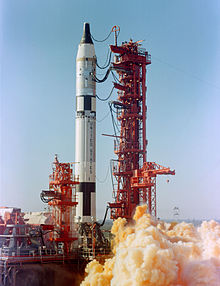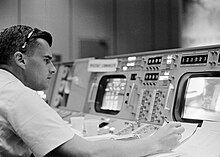Gemini 3
| Mission emblem | |||||||
|---|---|---|---|---|---|---|---|

|
|||||||
| Mission dates | |||||||
| Mission: | Gemini 3 | ||||||
| COSPAR-ID : | 1965-024A | ||||||
| Spacecraft: | Molly Brown | ||||||
| Launcher: | Titan II Gemini 62-12558 | ||||||
| Crew: | 2 | ||||||
| Begin: | March 23, 1965, 14:24:00 UTC | ||||||
| Starting place: | LC-19 , Cape Canaveral | ||||||
| Landing: | March 23, 1965, 19:16:31 UTC | ||||||
| Landing place: | Atlantic ; 22 ° 26'N / 70 ° 51'W | ||||||
| Flight duration: | 4h 52m 31s | ||||||
| Earth orbits: | 3 | ||||||
| Recovery ship: | USS Intrepid | ||||||
| Orbit inclination : | 32.6 ° | ||||||
| Apogee : | 224.2 km | ||||||
| Perigee : | 161.2 km | ||||||
| Covered track: | 128,748 km | ||||||
| Team photo | |||||||
 from left John Young and Virgil Grissom |
|||||||
| ◄ Before / After ► | |||||||
|
|||||||
Gemini 3 (GT-3) was the first manned flight of a US two-man spacecraft under the Gemini program .
crew
In the course of 1963, Deke Slayton , who was responsible for the division of the crew, provided Alan Shepard and Tom Stafford as crew for the maiden flight of the Gemini spacecraft. The reserve team should consist of Gus Grissom and Frank Borman .
However, Shepard lost his fitness to fly for health reasons, and so command passed to Grissom, and Walter Schirra became the new substitute commander . Stafford also lost his place in the main team. As the first astronaut of the second selection group, John Young should now come into play. Stafford slipped into the substitute team, Borman became substitute commander of Gemini 4 .
On April 13, 1964, NASA officially announced the crew: Grissom and Young as main crew, Schirra and Stafford as reserve.
Grissom continued the tradition of naming the spaceship. In memory of Liberty Bell 7 , his Mercury spaceship whose lander sank in the Atlantic, he named the Gemini spaceship Molly Brown , after the musical The Unsinkable Molly Brown . That kind of humor was not necessarily sympathetic at NASA, but Grissom's alternative Titanic was even less acceptable. This meant that the Molly Brown would remain the last NASA spacecraft with its own name until Apollo 9 .
For this short flight, two liaison officers ( Capcoms ) were sufficient to bundle the radio traffic between the spaceship and the control center: Gordon Cooper , who also had Mercury experience, from Cape Canaveral and Roger Chaffee from the third group of astronauts from Houston .
preparation
Since the Gemini spaceship was new, the four astronauts selected for the mission had to spend a lot of time in the simulator, first at McDonnell in St. Louis , and later in Cape Canaveral. Other exercises included jet flights, parachute jumps and getting out of the floating landing capsule.
The spacecraft was delivered to Cape Canaveral on January 4th, 1965, the Titan rocket on January 23rd, after which the spacecraft was assembled on February 17th. Another month was spent testing the entire system.
Flight history
Gemini 3 was launched on the morning of March 23, 1965. In addition to the technical tests, three scientific experiments were to be carried out during the flight, but they were only partially successful.
A sandwich that Young had smuggled on board to present to Grissom caused a stir , and the crumbs of which flew around in the spacecraft in zero gravity .
In orbit several course corrections have been made to check the function of controlling nozzles. The initially elliptical orbit was circularized and the plane of the orbit changed. The last time these nozzles were fired, Gemini 3 was placed in a relatively deep orbit that should result in a re-entry into Earth's atmosphere , even if the decelerator missiles should fail.
landing
After three orbits the earth the brake rockets were fired. The splashdown of parachutes carried out in two phases, wherein the first obliquely landing capsule with the nose up, then with the nose hung down to the parachutes. When moving from one position to the other, the two astronauts were thrown against the window. Young's helmet was scratched, and Grissom's visor even broke.
Because the air resistance of the landing capsule had been incorrectly estimated, Gemini 3 watered about 84 km from the calculated location. A rescue helicopter that took off from the USS Intrepid took about 30 minutes to reach the landing site. Grissom and Young did not dare to open the hatch until divers pulled a swim ring around the lander, fearing that Molly Brown might sink like the Liberty Bell .
The heat and rocking motion made both astronauts seasick .
The capsule is located in Spring Mill State Park, 2 miles east of Grissom's hometown of Mitchell, Indiana.
Importance to the Gemini program
The short test flight demonstrated the basic reliability of the Titan rocket as well as the Gemini spaceship and demonstrated the maneuverability in orbit. With the exception of minor glitches in the scientific experiments, all of the goals set were achieved. Thus, the preparations for the next Gemini missions could continue without delay.
See also
Web links
- NASA: Gemini-3-mission summary (English)
- NASA: Protocols of radio traffic (English; PDF)
- Gemini 3 in the NSSDCA Master Catalog (English)
- Report on Gemini 3 in the online archive of the Austrian Media Library


